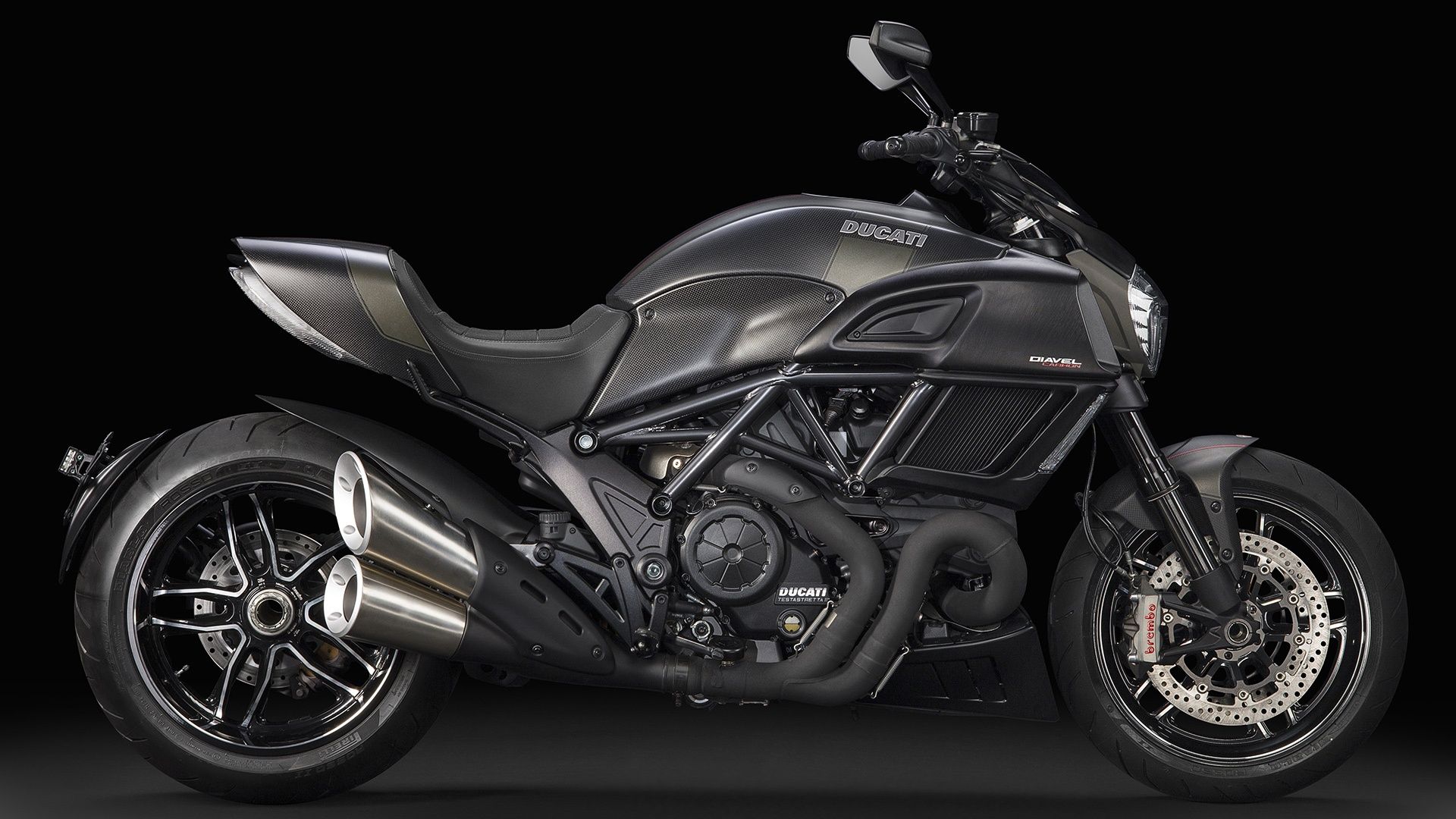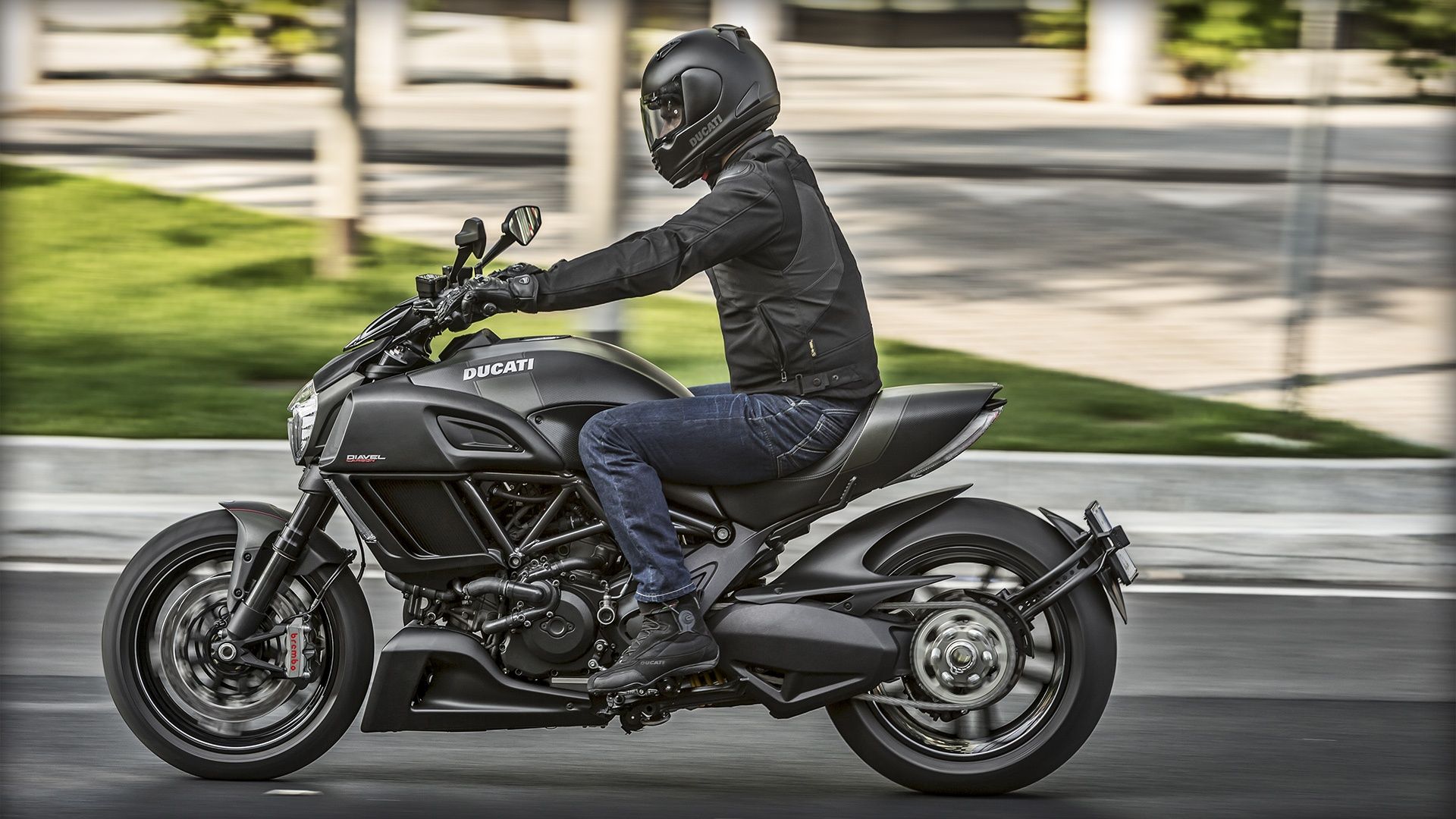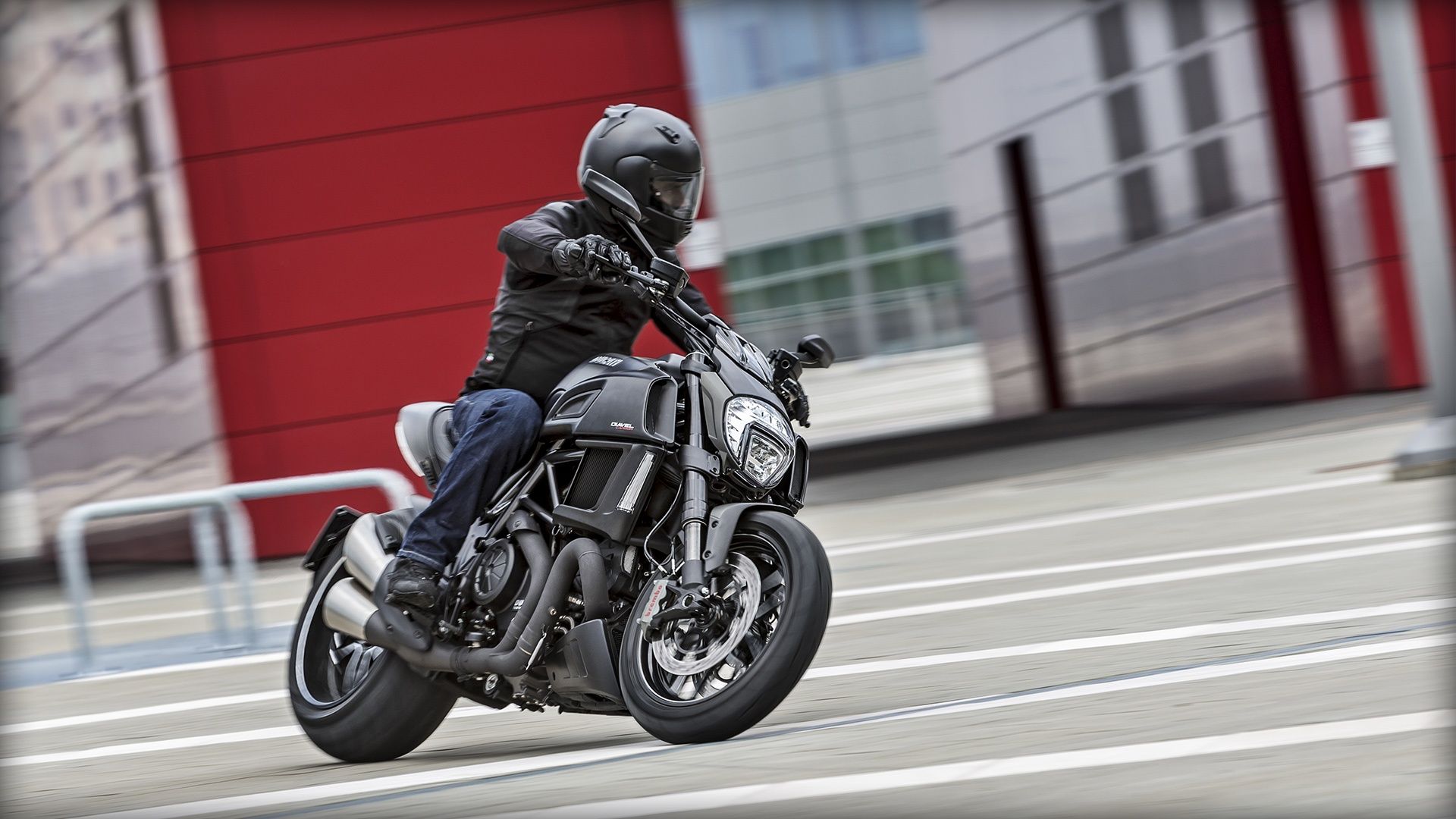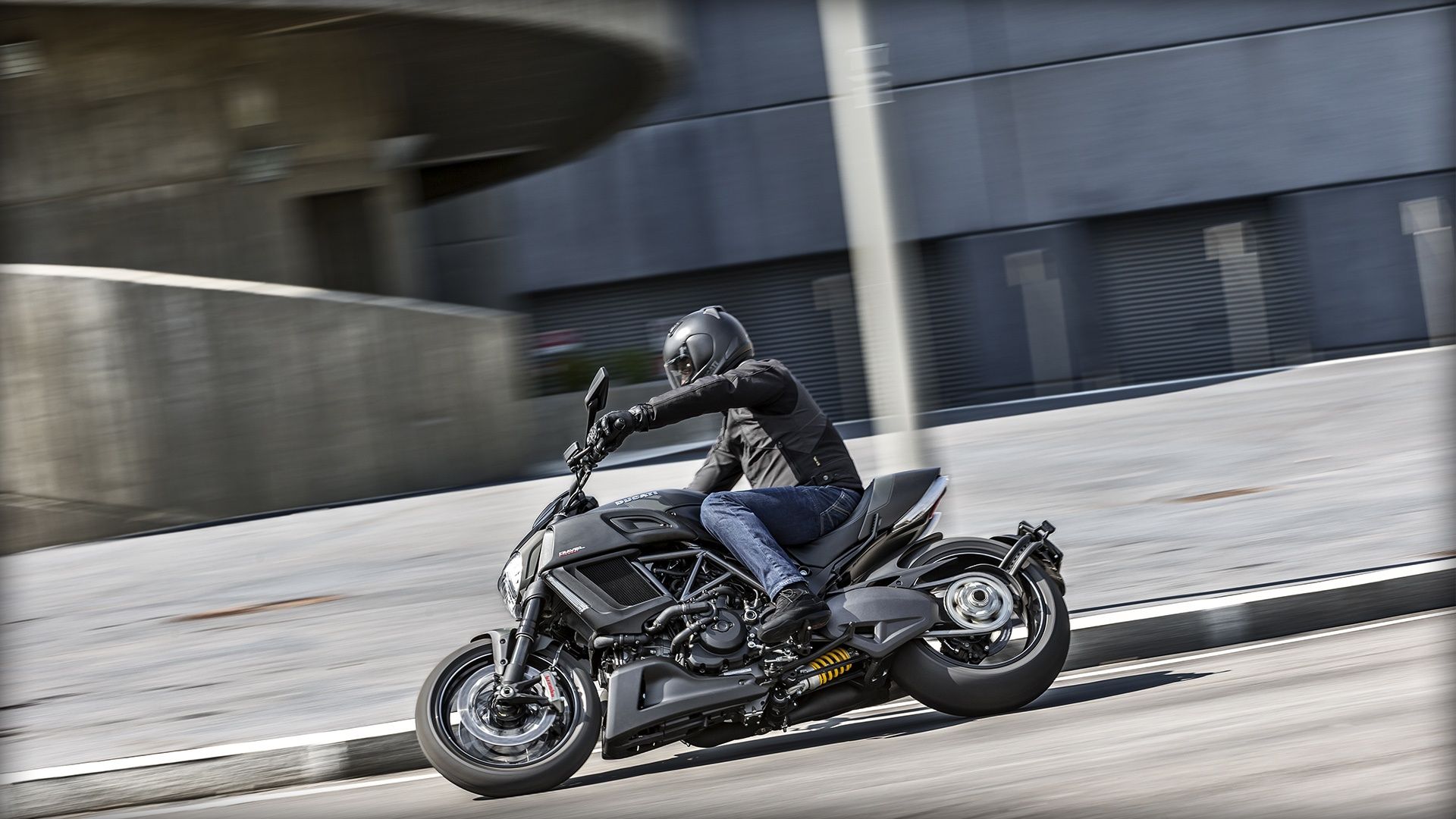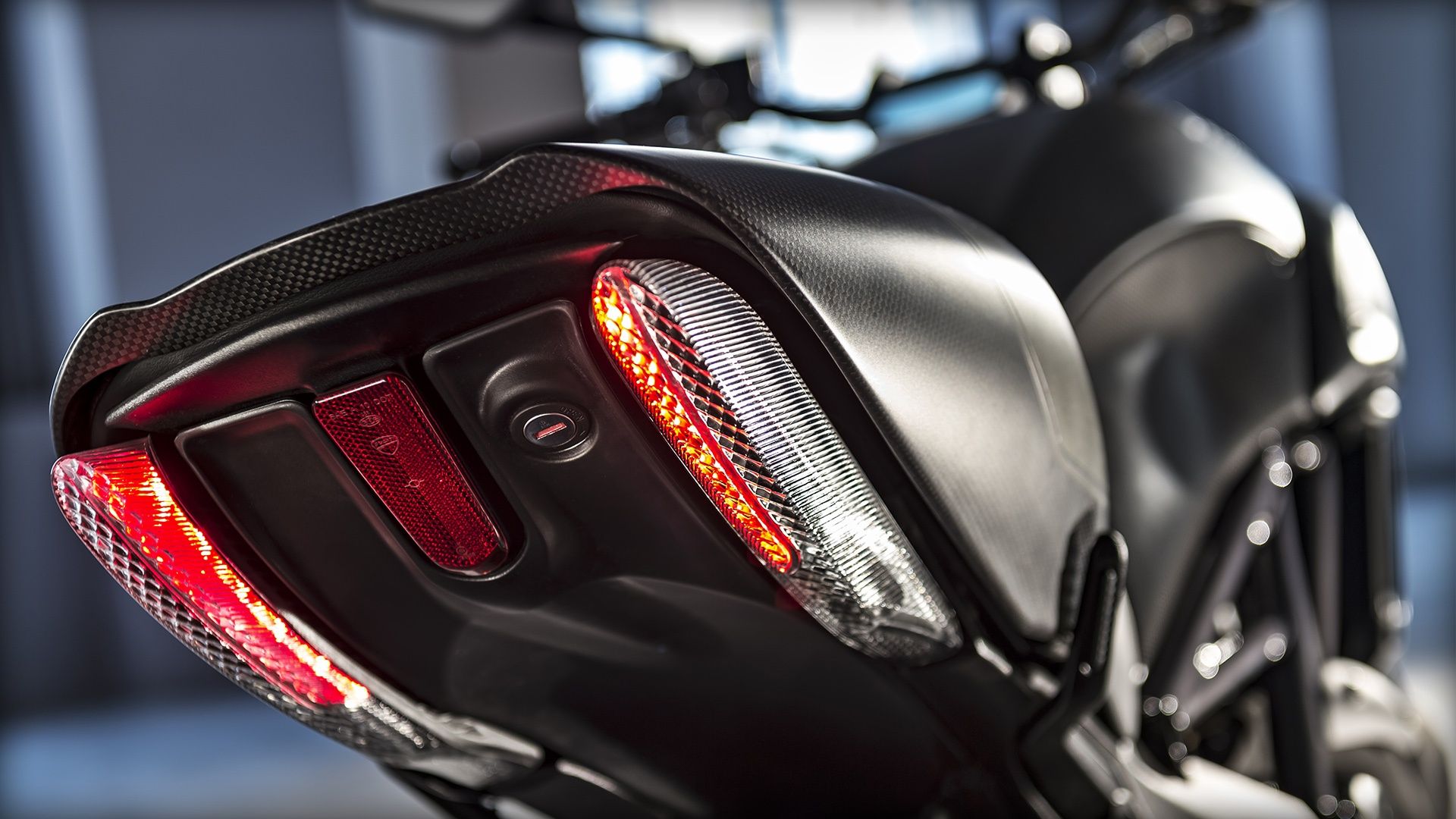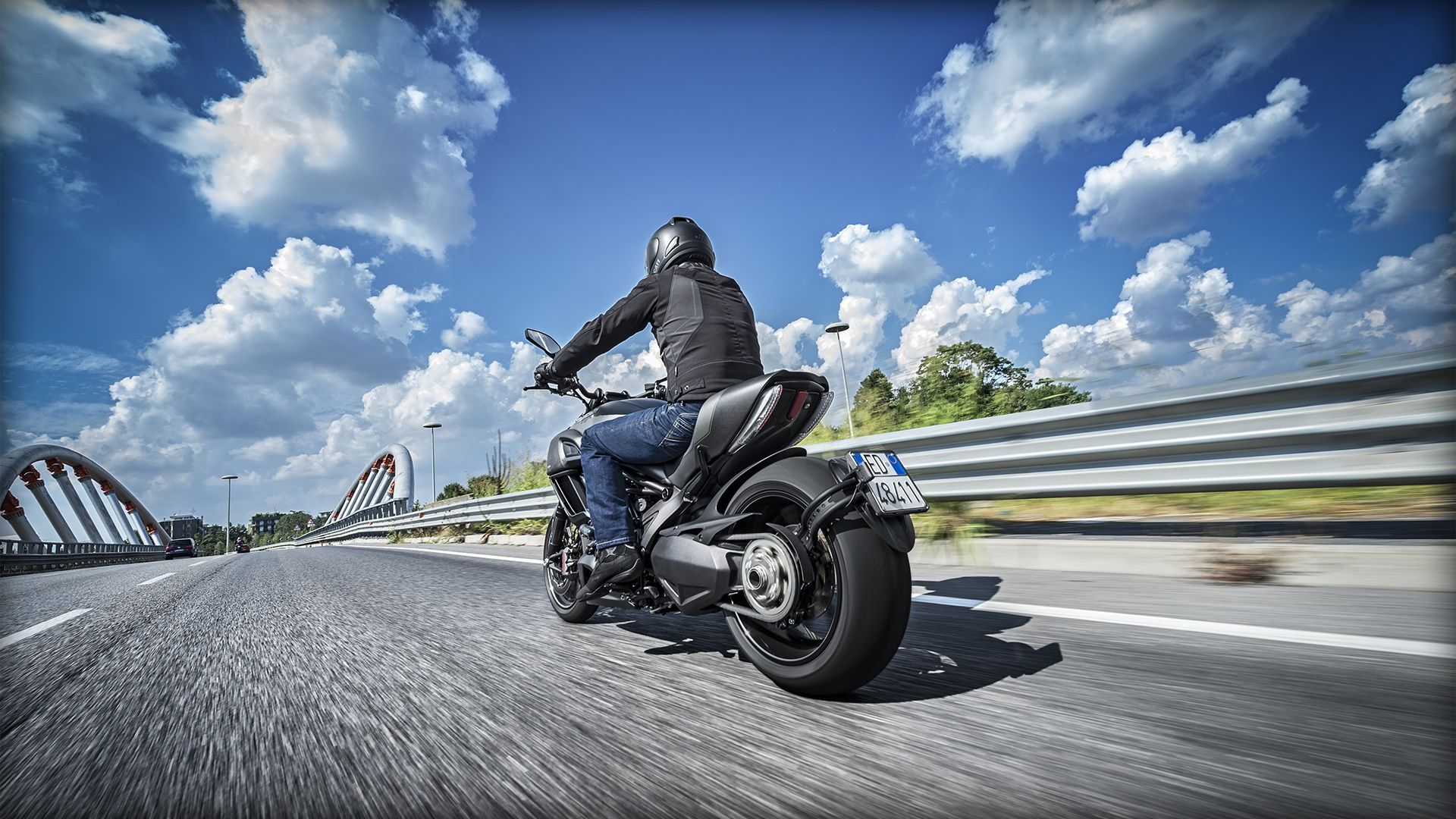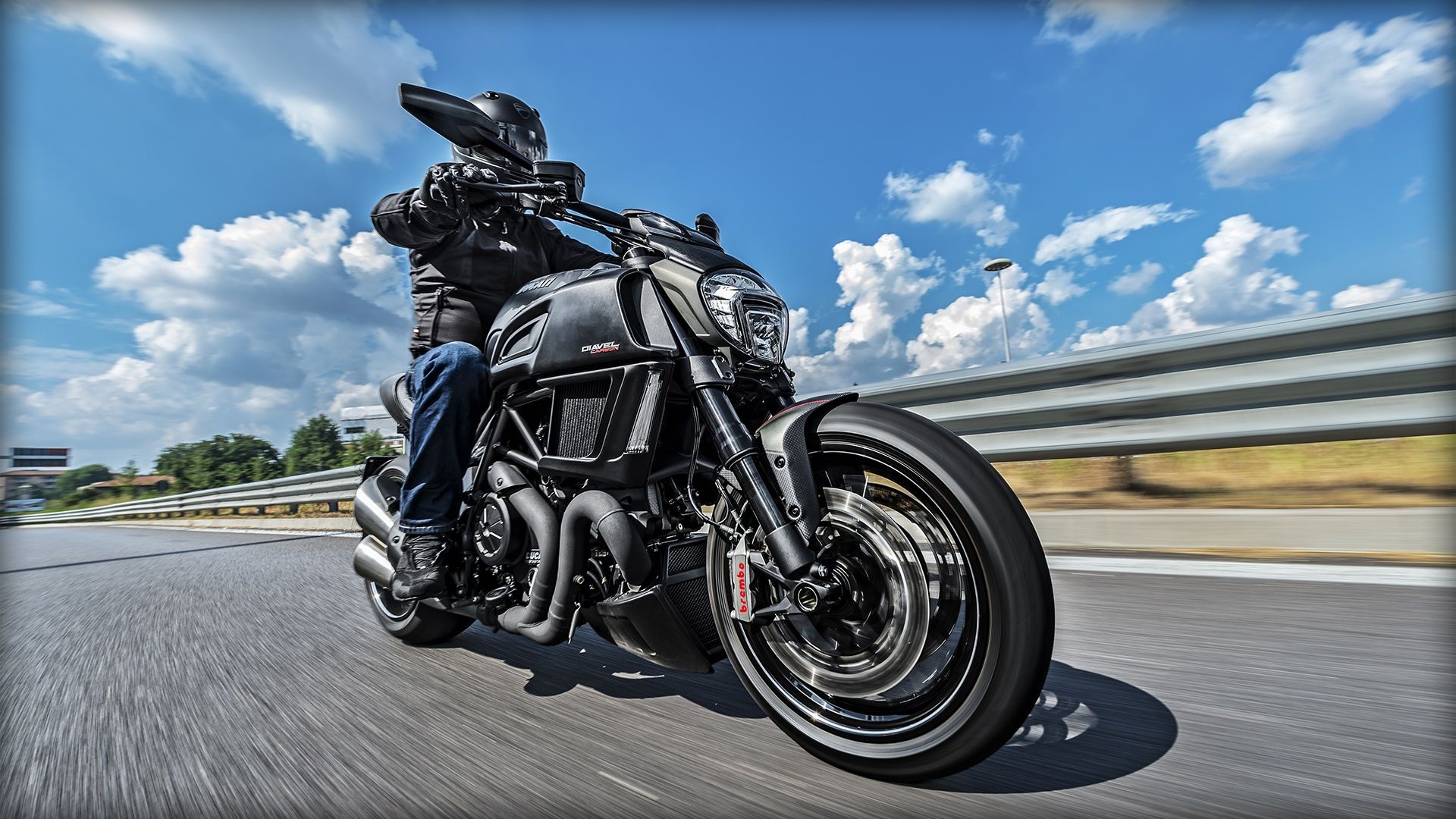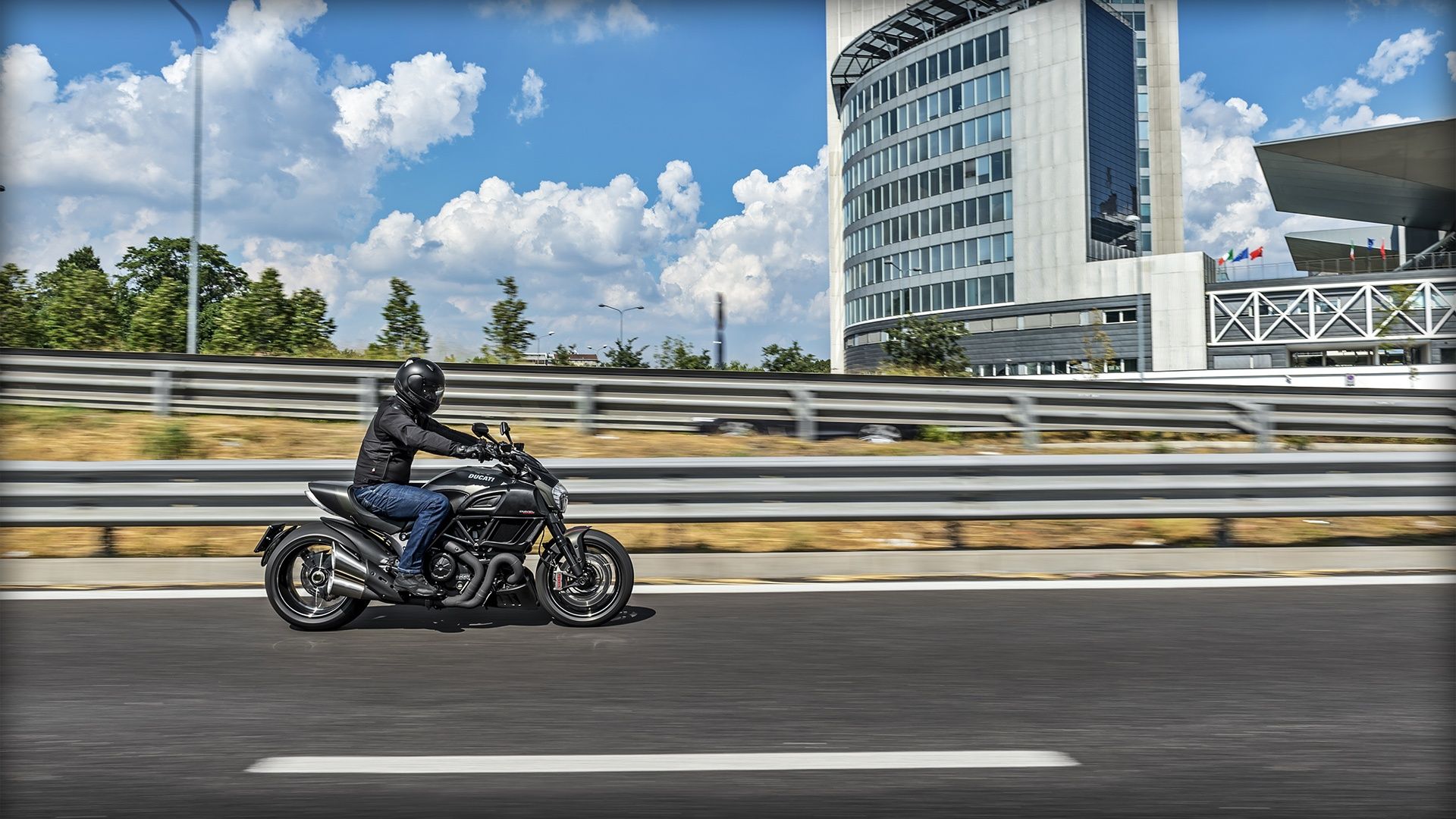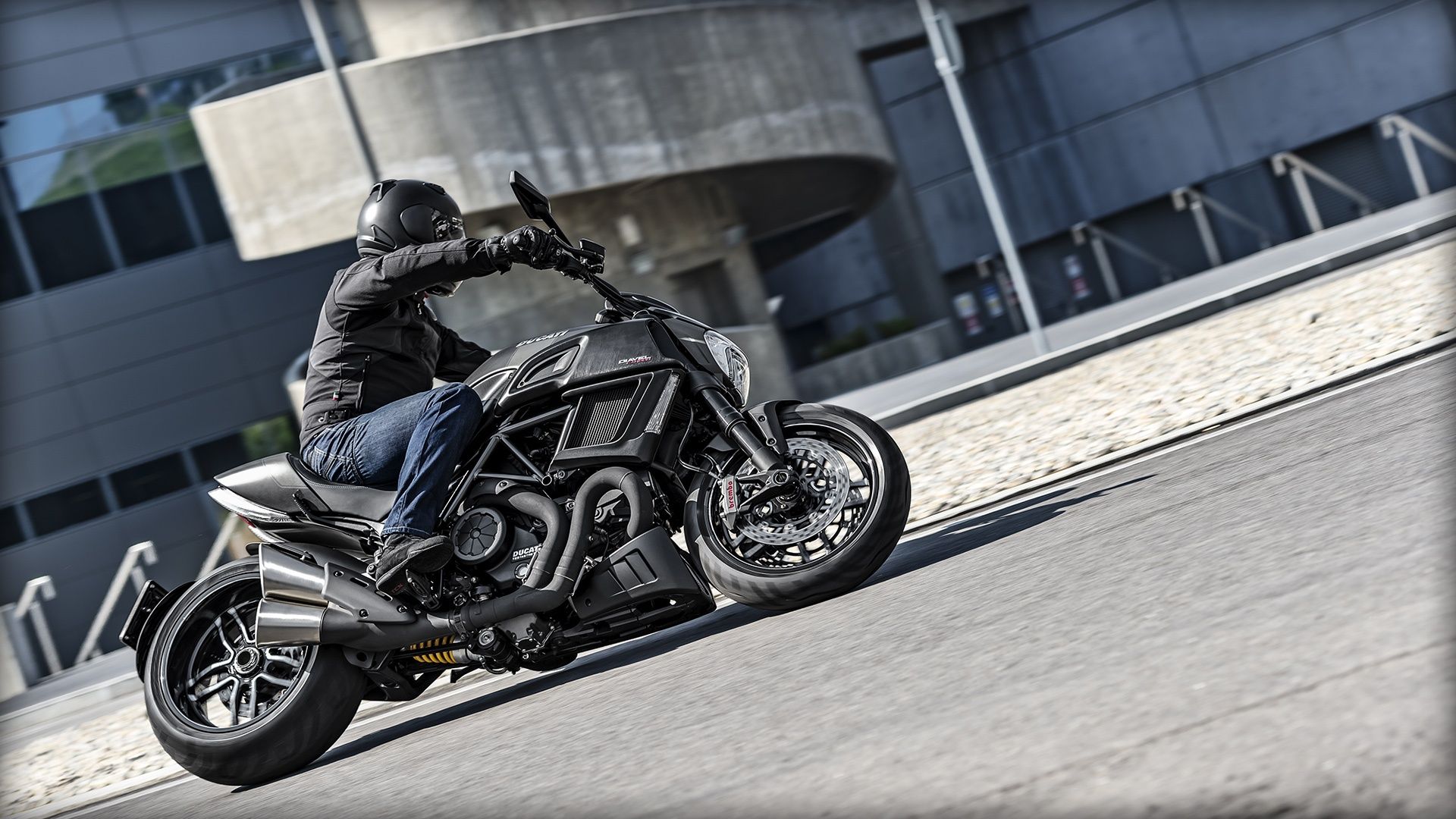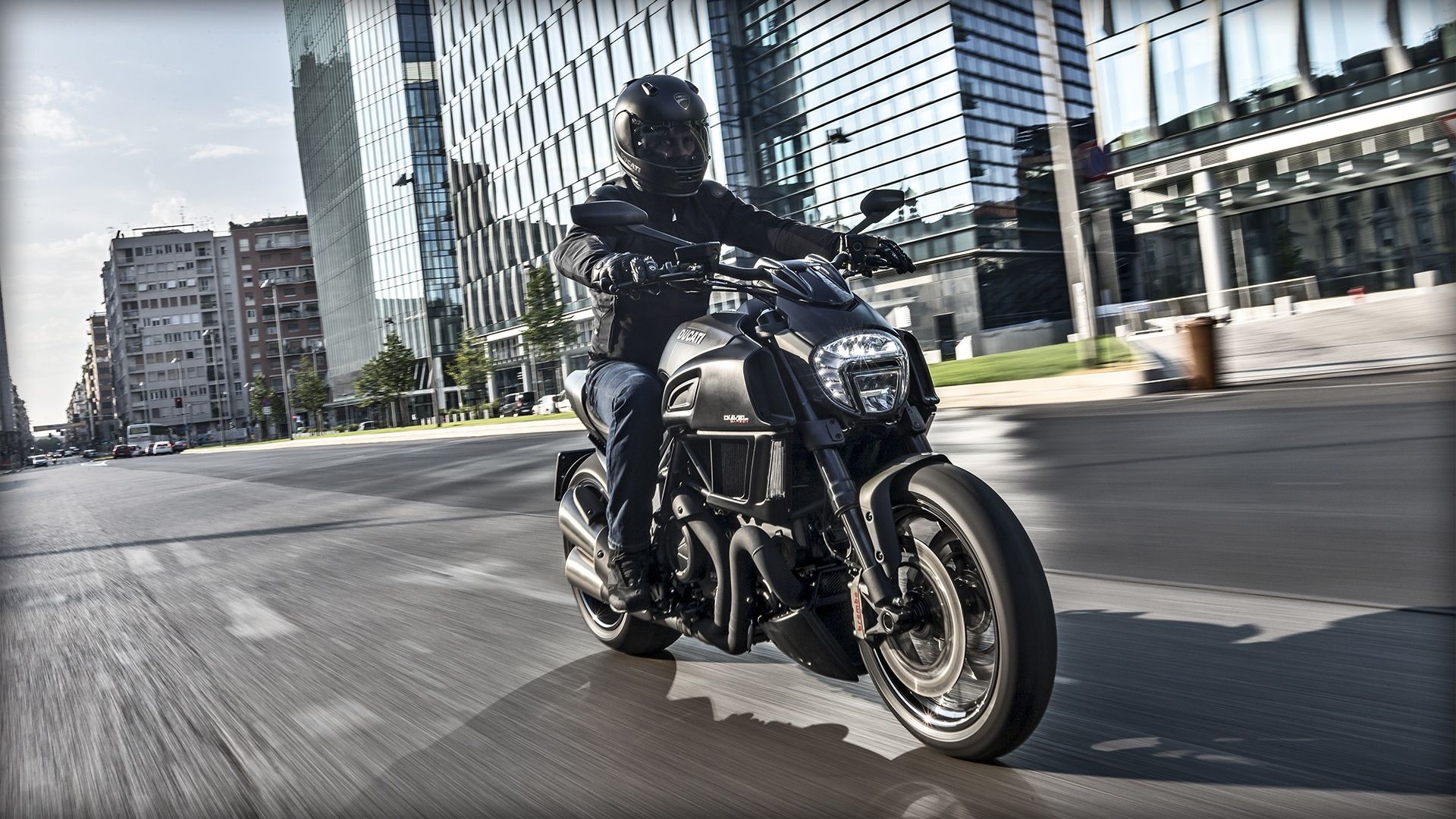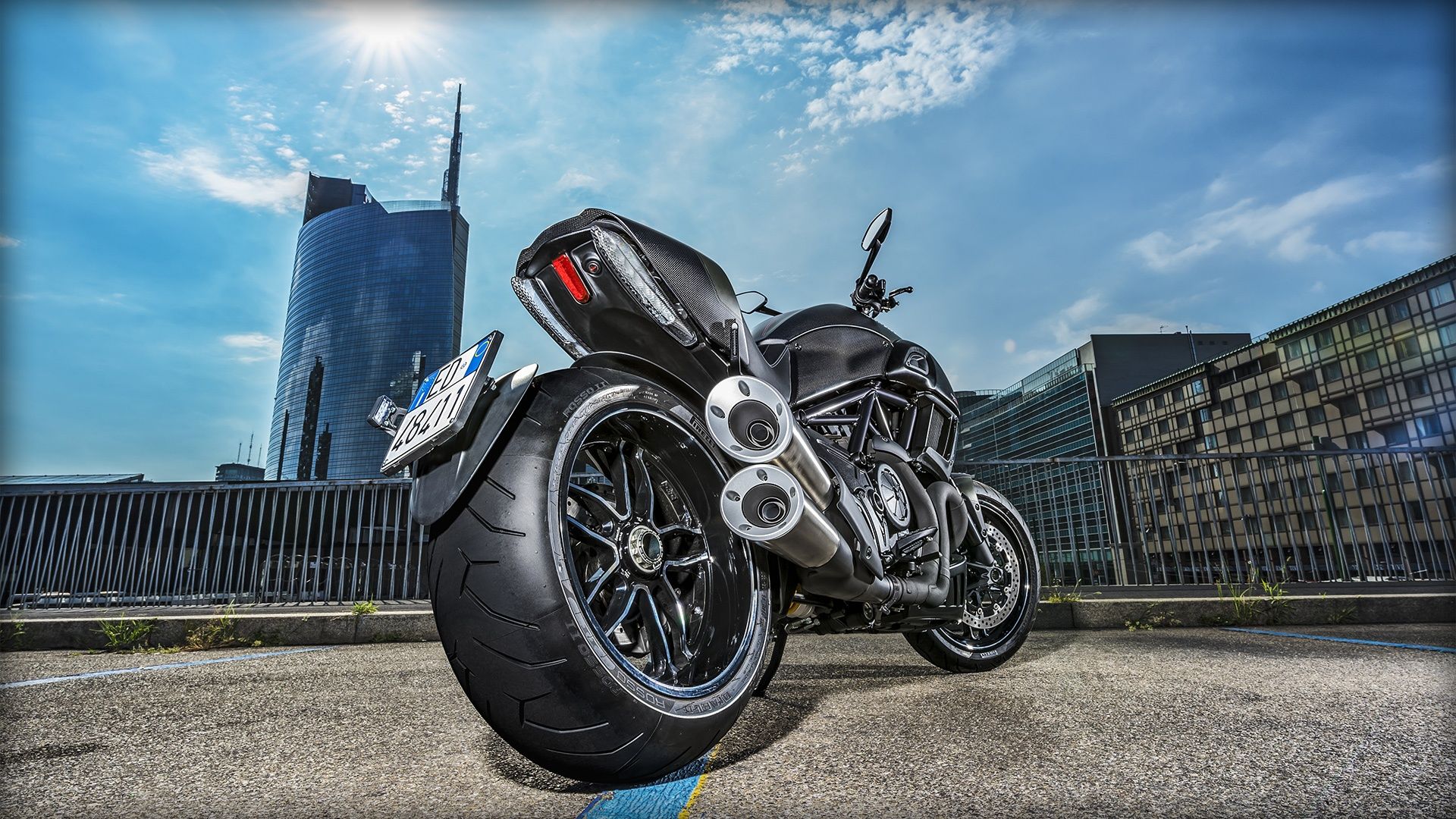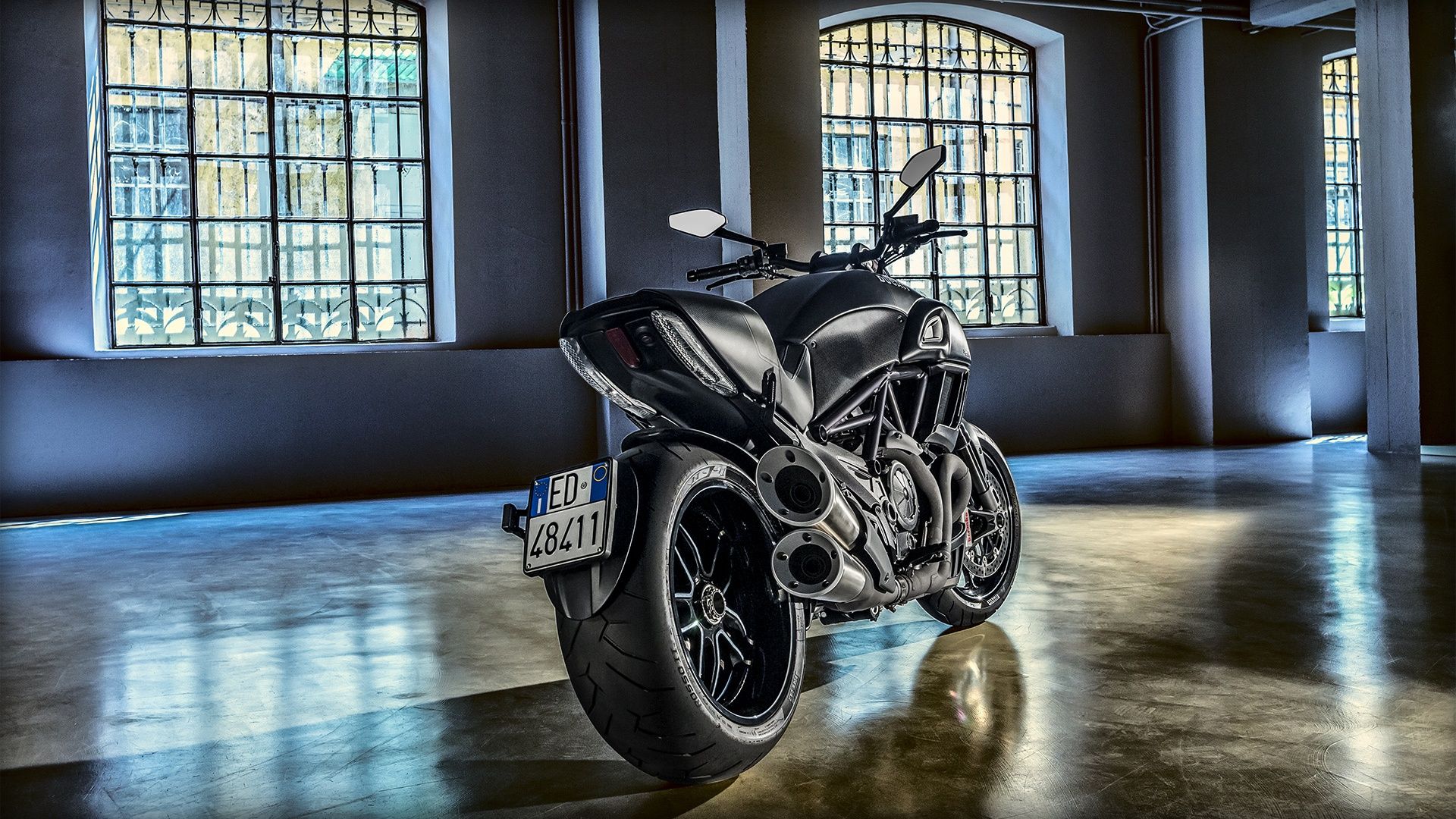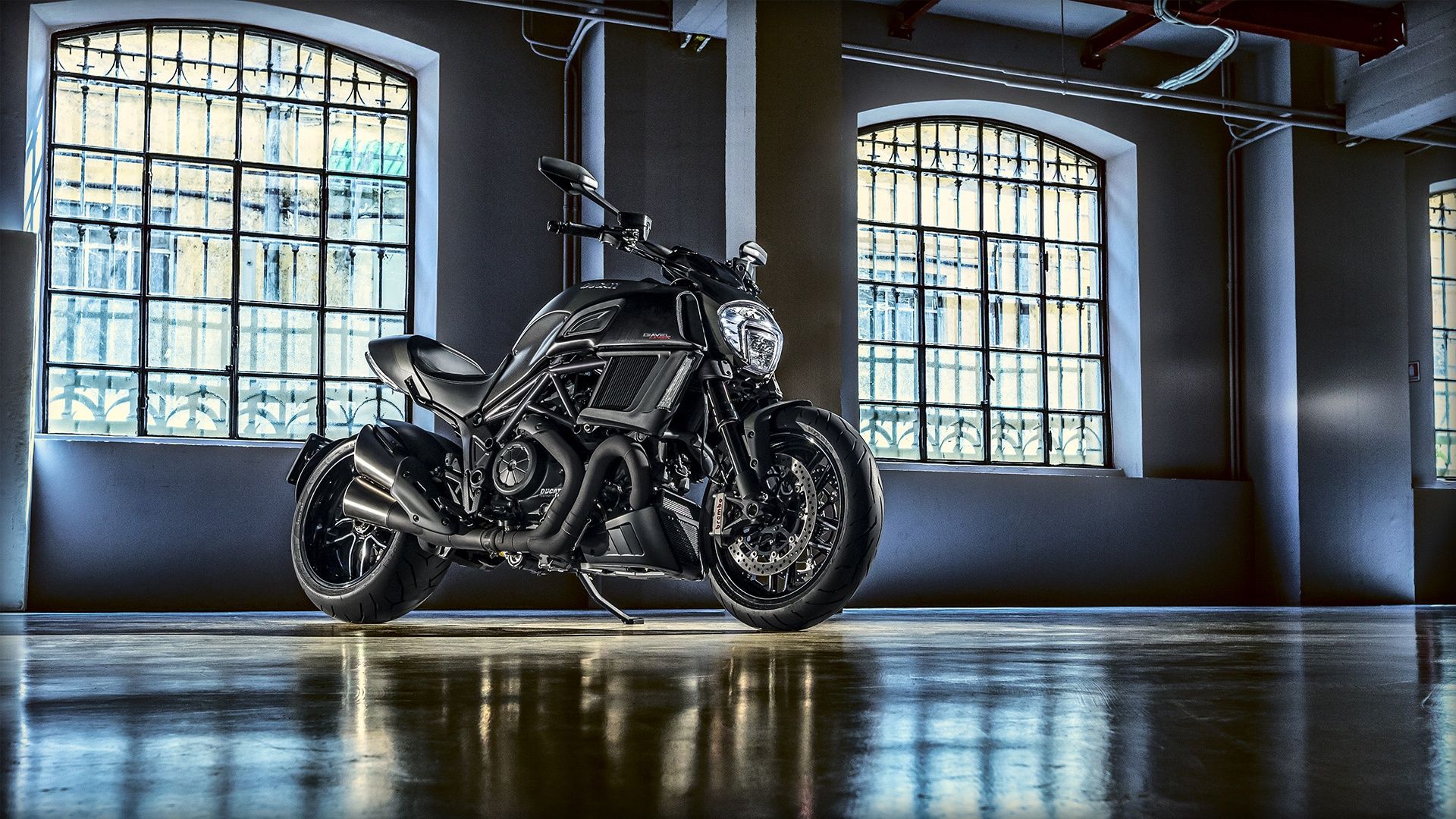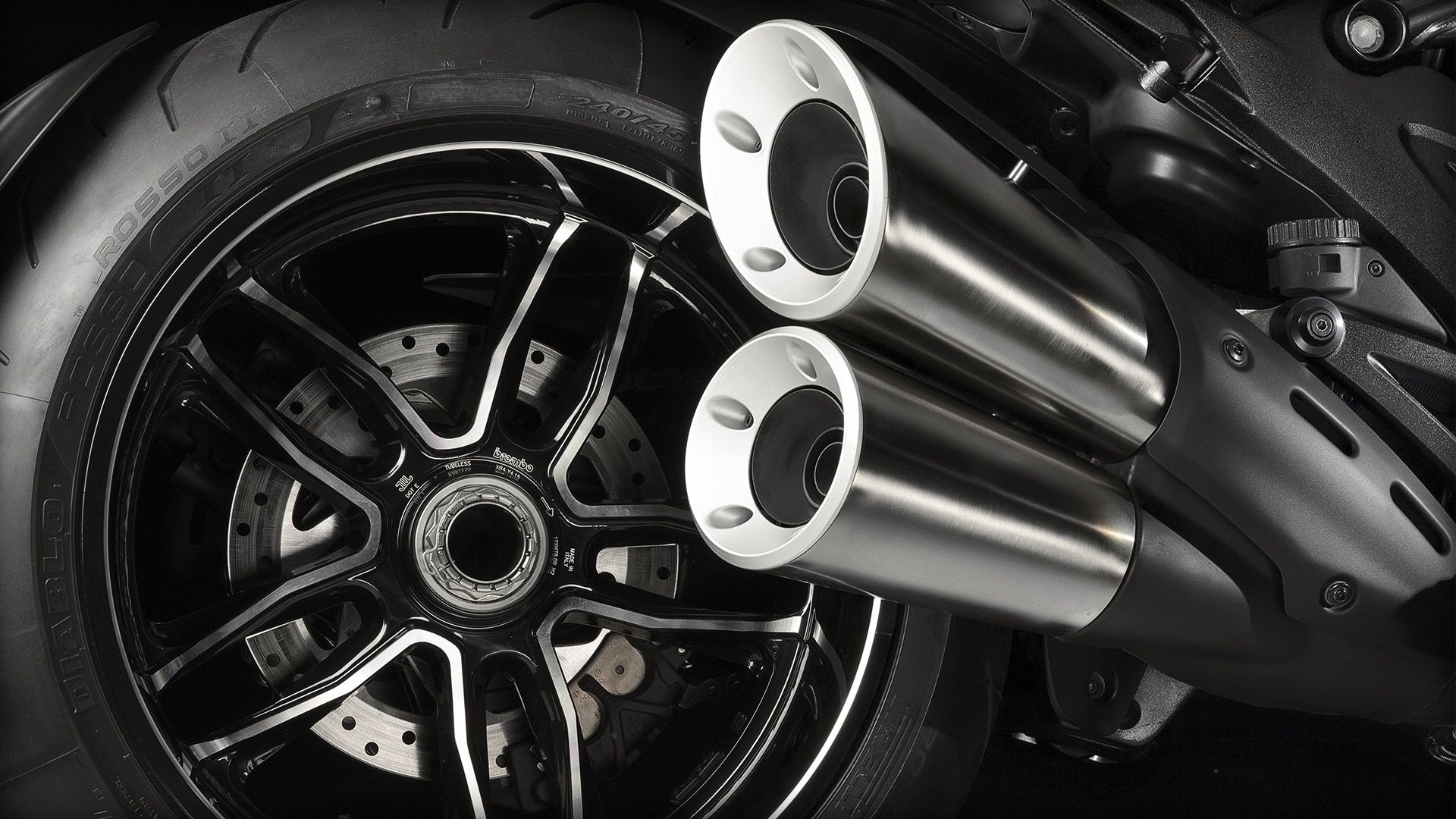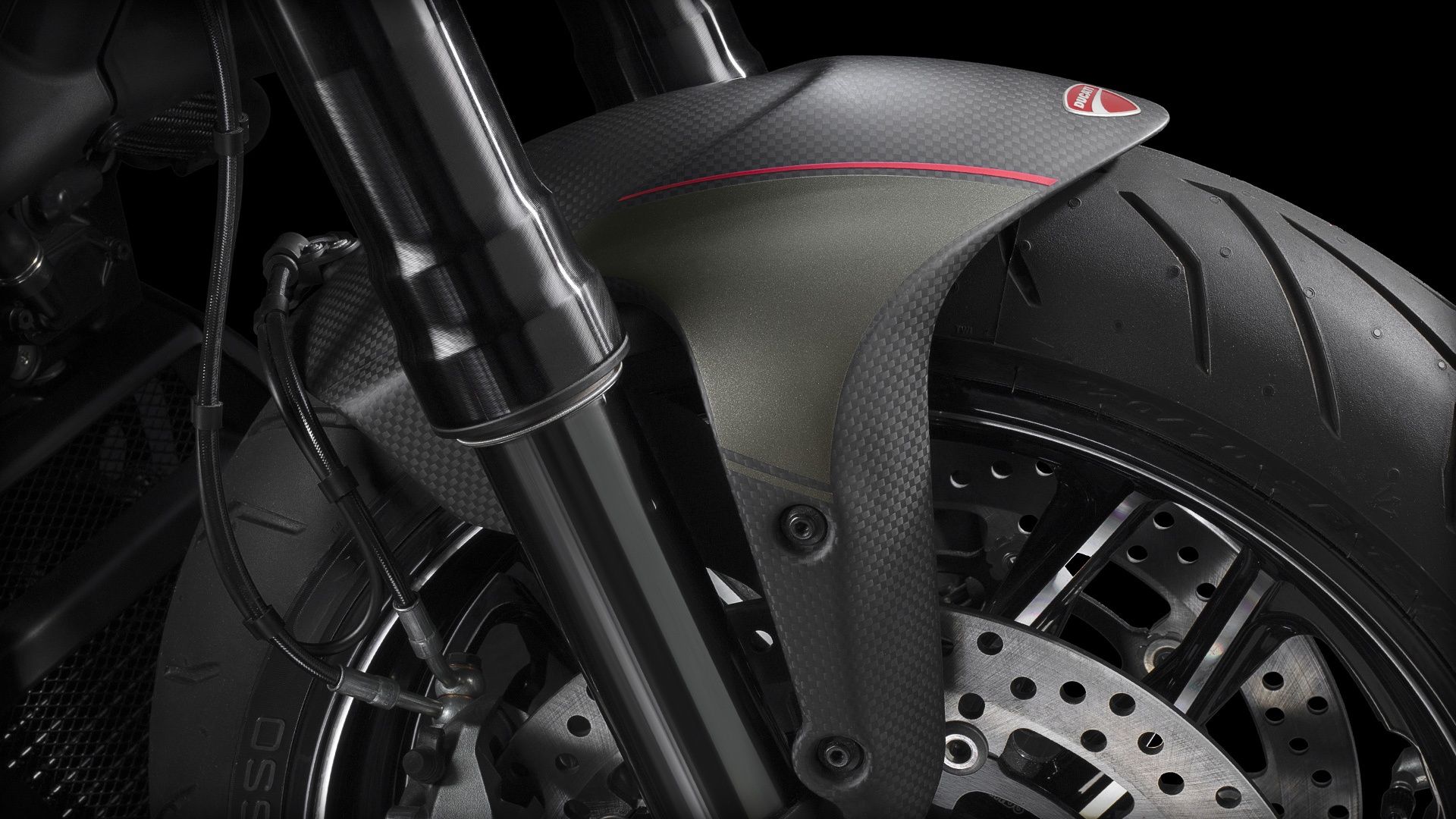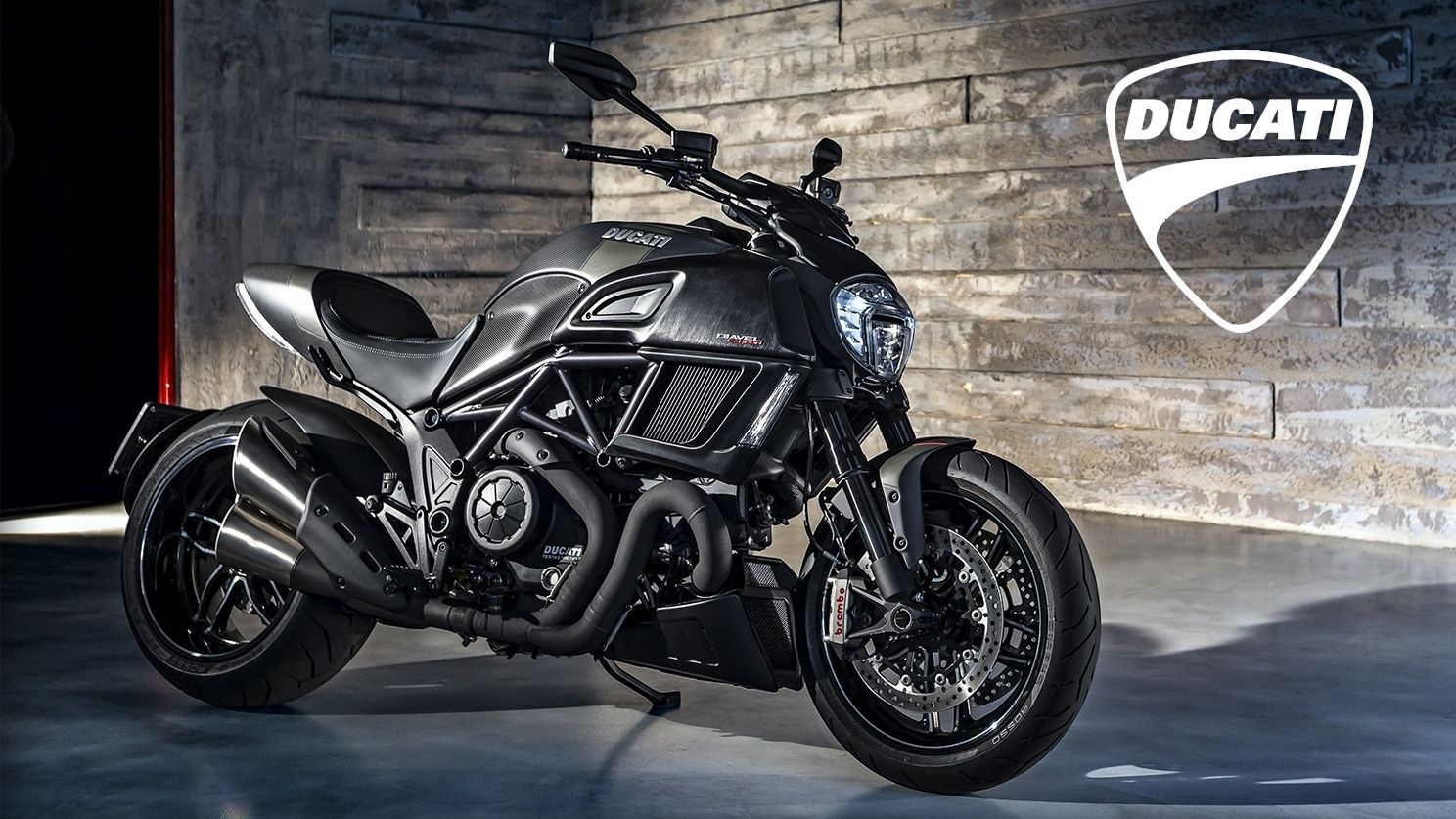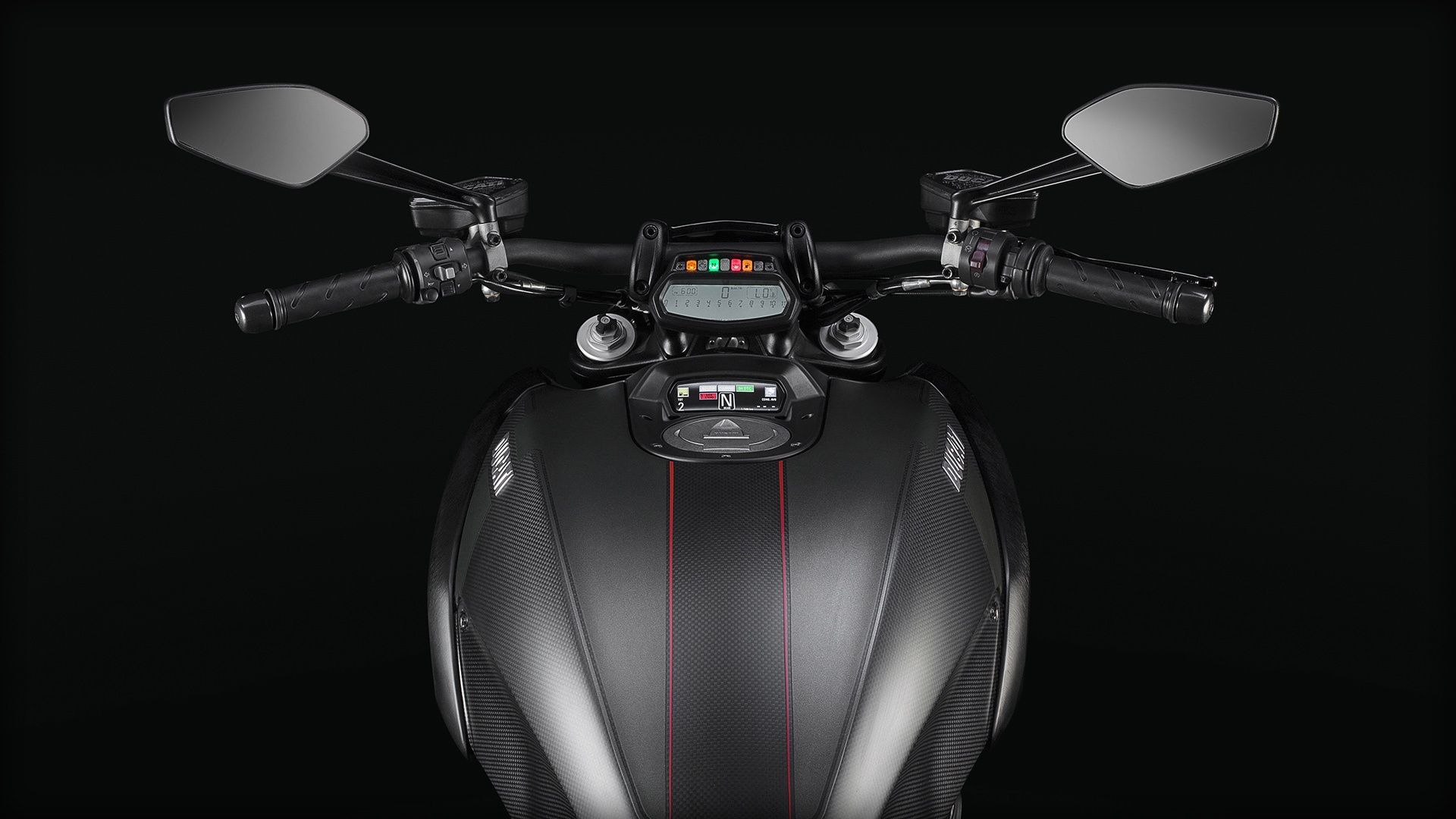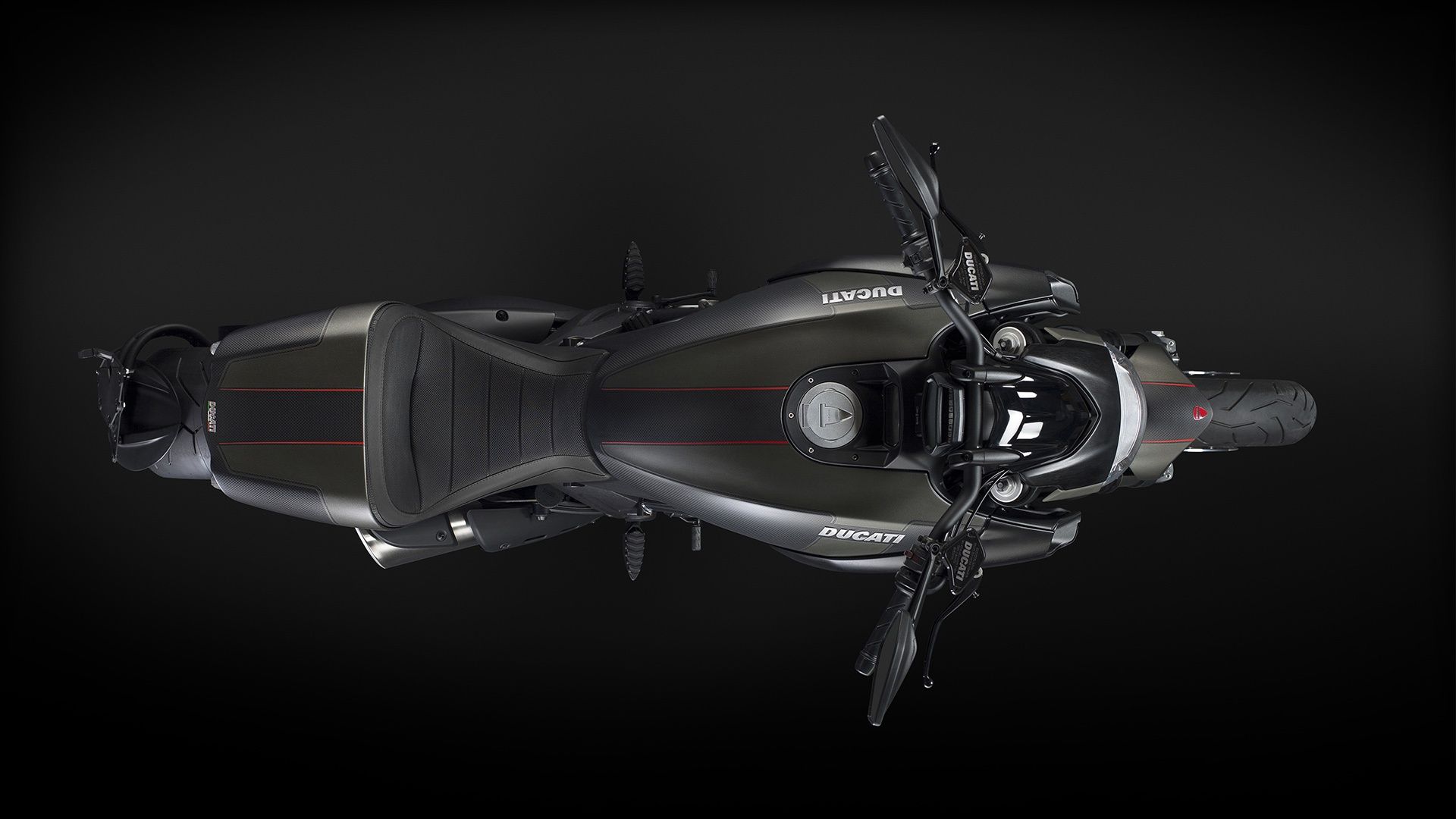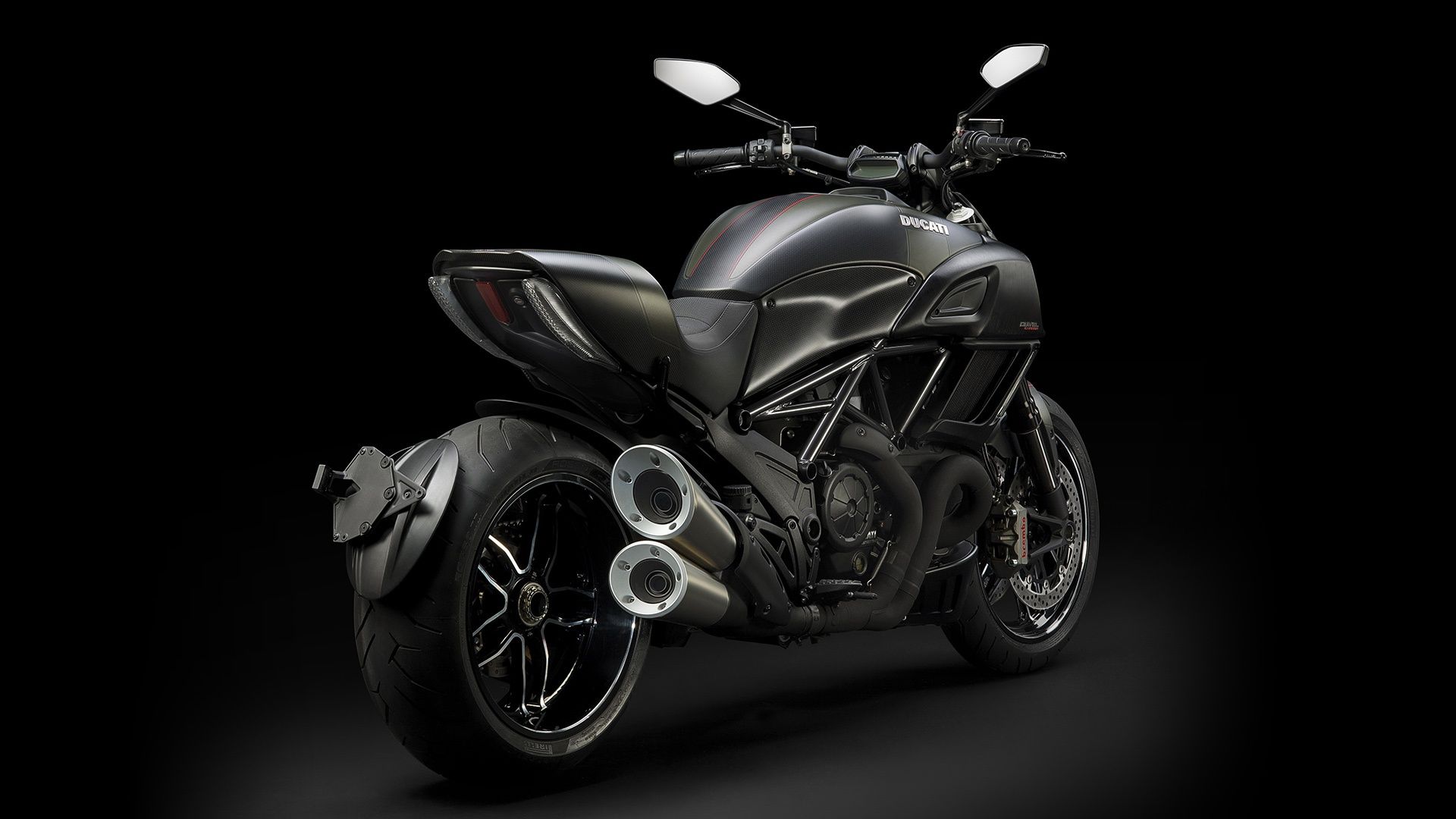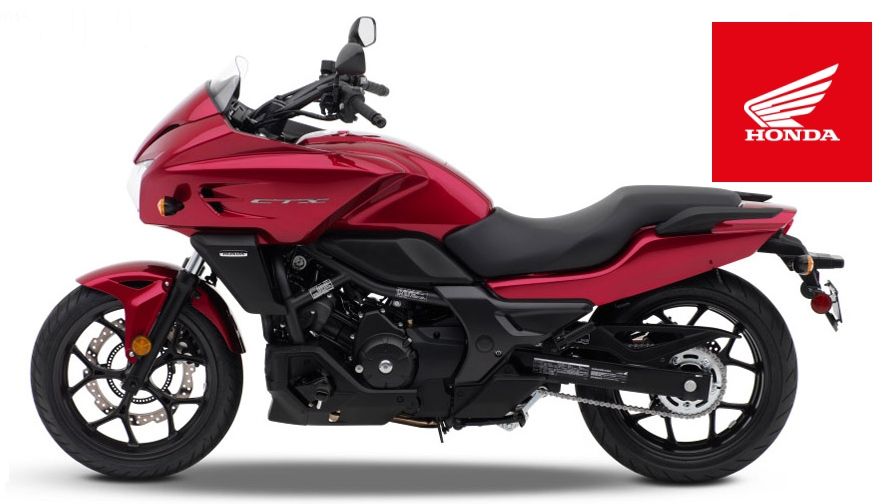Back in 2011, Ducati->ke622 released the Diavel->ke3688 as something of a “wish list” bike, embodying the personal desires of the engineering team. Since then, the factory has been polishing its pet project, and the 2016 Diavel Carbon represents the latest -- and lightest -- version of this rather unique-looking Italian power cruiser->ke392. Popular overseas, the Diavel has gained a foothold in the American market, mainly with more mature, experienced riders, and for reasons that are unclear to me, it is particularly popular among U.S. riders of the fairer sex. I love a good mystery, so let's dive in and see what the Diavel has that gives it such curb appeal.
Continue reading for my review of the 2016 Ducati Diavel Carbon.
ducati-diavel-carbon
- Make: Array
- Model: ducati-diavel-carbon
2016 Ducati Diavel Carbon
- Make: Array
- Model: 2016 Ducati Diavel Carbon
- Engine/Motor: L-Twin
- [do not use] Vehicle Model: Array
Design
Right off the bat, I gotta say that this bike does not follow any sort of cookie-cutter format so prevalent amongst the sportier rides out there. Built like a wedge of cheese, the Diavel Carbon is all up front, visually at least. Radiator cowlings forward of the long and gently curved fuel tank bump form the points of the wedge, and the rest of the bike tapers down to a barely-there subframe and seat. Carbon body panels set this model apart from the base-model Diavel to give it an even more modern appearance, and billet aluminum parts lower the overall weight while preserving structural integrity. Saddle shape is rather extreme, but the depth of the scoop isn't just for show, it's necessary to prevent you from un-assing the bike when you grab a fistful and twist!
As loathe as I am to quibble about semantics, I have to question the “power-cruiser” classification. Yeah, you can adopt a rather upright riding position, but that quality isn't necessarily enough by itself to make it a cruiser given the overall look of the bike, and the 162 horsepower, superbike->ke1888-inspired Testastretta mill. It's not a big deal, but to me the word “cruiser” comes with certain implications, and buyers that are interested in this kind of power and panache may be put off by that categorization.
Chassis
The bones of the rolling chassis form a trellis frame that both supports and protects the engine, plus it looks really cool where it peeks out under the body panels and airbox intake scoops. Steering head angle and the 24 mm, triple-tree offset combine for 28 degrees of steering rake and 5.1 inches of trail for a balance between straight-line stability and cornering. At 30.3-inches high, the saddle falls within range of all but the shortest riders and allows easy access to the ground, possibly contributing to its popularity with the gal riders.
Massive 50 mm, inverted front forks come blacked out, fully adjustable and with Ducati's Diamond-Like Carbon (DLC) coating for low friction operation. The single-sided, aluminum swingarm rides on a Sachs monoshock with a progressive linkage and remote preload adjuster. No automatic or dynamic suspension control, but it is meant to be a “cruiser” after all, not a race bike. (I submit that it's some combination thereof.)
Pirelli Diablo Rosso II hoops wrap the 17-inch Marchesini 10-spoke rims, and come built to provide wet-weather traction and sport-style grip all the way through the (unspecified) lean angle. The rubbers are big and fat, with a 120/70 up front and a 240/45 in back, making for two very large contact patches for the sticky, bi-compound, Enhanced Patch Technology (EPT) tires to work with.
The brakes bring us into the first active rider-safety system on this ride, with a Bosch ABS to manage the brakes; good thing too, 'cause there are plenty of them. Dual, four-pot Brembo Monobloc calipers bind the 320 mm front brake discs, and a twin-piston Brembo caliper binds the 265 mm disc in back. While ABS doesn't necessarily make for shorter stops, it certainly makes for safer ones with the system intervening as soon as it detects slippage.
Drivetrain
Now for the pièce de résistance, the Testastretta 11-degree engine, so named for the 11 degrees of valve overlap that occurs near TDC at the end of the exhaust stroke, and the beginning of the intake for improved exhaust-gas scavenging and cleaner charges. Dual-plug heads improve flame-front propagation for max power and reduced emissions. To reduce emissions further, fresh-air induction in the exhaust system burns off any remaining free hydrocarbons in the waste-gas stream.
The Ride-by-Wire (RbW) L-twin engine comes liquid-cooled, and uses Ducati's signature Desmodromic valvetrain for safe and precise control over the valves, even up against the 10K rpm mark. With 1,198.4 cc at its disposal, this mill cranks out a sphincter-tightening 162 ponies at 9,250 rpm, and 96.2 pound-feet of grunt at 8,000 rpm. Lots of power, but fear not, our Italian engineers made sure to give us a collar for the beast. That collar comes in the form of the Ducati Traction Control (DTC) system that reads wheel speeds and intervenes through the RbW system to prevent loss of traction from over-acceleration. Additionally, the Riding Mode function allows for push-button (even on the fly) selection between the Urban, Touring and Sport power curves, so you can use a preset map to tame the bike to the conditions or your skill level, or program your own custom curves.
A slipper-clutch uses a “self-servo” mechanism that partially replaces the clutch springs for a light pull at the lever, and positive engagement when getting on the power. Additionally, when you roll off to scrub some speed ahead of a curve, the clutch slips a bit to limit back-torque, and eliminate loss of traction from excessive engine-braking.
Competitor
Since 160+ horsepower “cruisers” are fairly hard (read: next to impossible) to come by, I went with last year's CTX700 from Honda->ke291 for the competitor pick, based mainly on the cruise-tastic setup that gives it roughly the same vibe as the Diavel.
Right off the bat, I feel compelled to mention that engine-wise, these two bikes are like chalk and cheese. Honda is typically tight-lipped on the performance numbers, but the 670 cc parallel-twin mill can't hold a match to the Ducati's 1198.4 cc plant. Additionally, the CTX comes sans all the nifty traction control and engine maps, but honestly, I don't expect it needs them with such a small mill.
Honda does offer a feature that Ducati doesn't; while you can get it with a six-speed manual transmission, you can also opt for the automatic transmission model that you can operate as a full automatic, or a semi-auto with push-button shifting. This feature alone makes it particularly suited for beginners, a demographic that would do well to avoid stupidfast bikes, at least until they put a few tens-of-thousands of miles behind them.
ABS comes standard on the Diavel. It is available on the CTX as well, but only as an option; and Honda went with a single front brake instead of dual -- a move I rarely agree with except on the smallest of bikes.
You can ride either bike in an upright position, though the CTX almost forces this position with its forward foot controls. I like feet-forward riding, but it does place you in a windsock position that can get a little wearisome on long rides, or at least high-speed ones. Bottom line: both are capable of sporty cruising activities, but one of them (cough Diavel cough) is certainly the sportier of the two. Of course, just because you have all that power does not necessarily follow that you must use it, but it sure is fun when you do!
He Said
“Ducati does not disappoint, with all the power and features we come to expect from our Italian buddies, and a cool, if unusual, overall design. I still question its utility as a cruiser, and prefer to think of this sled as more of an athlete in slightly frumpish clothes. Given the awesome performance numbers, and an unofficial top speed around 160+, this is definitely a ride for someone wanting a thoroughbred betwixt their legs, not just a point-A-to-point-B sled.”
She Said
My wife and fellow writer, Allyn Hinton, says, "Really? It's a mystery as to why this bike is popular among women? I do love my husband, but he is a man with a man's brain. Women -- usually being shorter than the average man -- tend toward the cruisers because the American-style cruisers traditionally have low seat heights, low center of gravity and mid-mount controls. The Diavel Carbon is one of the few stupidfast bikes with a seat height 30 inches or less. (Yes, I know Ducati calls this a cruiser, but like my husband, I think it doesn't really fit into the American definition of "cruiser.") Other bikes in the stupidfast family, such as the Hayabusa->ke1989 from Suzuki->ke371 or the Ninjas from Kawasaki->ke299 are tall bikes with seat heights of 32 or 33 inches. The Diavel Carbon is one of the few go-fast bikes that we of the less-than-the-average-man height can ride comfortably. Cruising is fine, but sometimes we like to go fast, too."
stupidfast0}
|
stupidfast} |
Testastretta 11-degree L-Twin, Four Desmodromically actuated valves per cylinder, liquid cooled |
|
Engine Type: |
1,198.4 cc |
|
Displacement: |
106 x 67.9 mm |
|
Bore x Stroke: |
12.5:1 |
|
Compression Ratio: |
162 Horsepower at 9,250 rpm |
|
Maximum Power: |
96.2 Pound-Feet at 8,000 rpm |
|
Maximum Torque: |
Electronic fuel injection, elliptical throttle bodies, fully ride-by-wire controlled |
|
Fuel injection: |
Stainless steel silencer with brushed steel outer cover; catalytic converter and 2 lambda probes, manifolds coated with black ceramic Zircotec |
|
Exhaust: |
Six-speed |
|
Transmission: |
Straight cut gears, ratio 1.84:1 |
|
Primary Drive: |
1=37/15 2=30/17 3=27/20 4=24/22 5=23/24 6=22/25 |
|
Gear Ratios: |
Chain drive; 15-tooth front sprocket, 43-tooth rear sprocket |
|
Final drive: |
Slipper and self-servo wet multiplate clutch with hydraulic control |
|
Clutch: |
|
|
Chassis: |
Tubular steel Trellis frame with Dark Chrome paint |
|
Frame: |
Fully adjustable 50 mm inverted fork with DLC-treatment,4.7-inch travel |
|
Front Suspension: |
Fully adjustable rear shock with progressive linkage. Remote spring preload adjustment. Single-sided aluminum swingarm, 4.7-inch travel |
|
Rear Suspension: |
28 degrees |
|
Rake: |
5.1 inches |
|
Trail: |
Dual 320 mm semi-floating discs, radially attached Brembo Monobloc Four-piston calipers with ABS as standard equipment |
|
Front Brake: |
265 mm disc, Two-piston floating caliper ABS as standard equipment |
|
Rear Brake: |
Marchesini forged and machined 10-spoke 3.50 x 17 |
|
Front Wheel: |
Marchesini forged and machined 10-spoke 8.00 x 17 |
|
Rear Wheel: |
120/70 ZR 17 Pirelli Diablo Rosso II |
|
Front Tire: |
240/45 ZR17 Pirelli Diablo Rosso II |
|
Rear Tire: |
Handlebar mounted instrumentation with LCD display: speed, rpm, time, coolant temp. Warning lights for: Neutral, turn signals, high-beam, rev-limit, DTC intervention, ABS status, oil pressure, fuel reserve. Tank mounted instrumentation with TFT colour display: gear selected, air temp, battery voltage, trips 1 & 2, fuel reserve trip, average and actual fuel consumption and speed, trip time, scheduled maintenance. Full status and/or management of Riding Modes, DTC, RbW and ABS. |
|
Instrumentation: |
|
|
Dimensions and Weight: |
452 Pounds |
|
Dry weight: |
516 Pounds |
|
Wet weight: |
4.5 Gallons |
|
Fuel Tank Capacity: |
Dual seat |
|
Number of seats: |
|
|
Dimensions: |
88 inches |
|
Length: |
34 inches |
|
Width: |
47 inches |
|
Height: |
30 inches |
|
Seat Height: |
62 inches |
|
Wheelbase: |
Riding Modes, Power Modes, Ducati Safety Pack (ABS + DTC), RbW, Hands-Free, full-LED headlight, front turnsignals with guidelights, carbon fibre components |
|
Standard Equipment: |
|
|
Details: |
24-month unlimited mileage |
|
Warranty: |
Asphalt Gray and Matt Carbon |

